#sophia goudstikker
Text

Sophia Goudstikker (deceased)
Gender: Female
Sexuality: Lesbian
DOB: 15 January 1865
DOD: 20 March 1924
Ethnicity: Ashkenazi Jewish
Nationality: Dutch / German
Occupation: Photographer, women's rights activist, self taught lawyer
Note 1: Was the inspiration for three different writers' depictions of a more masculine woman, who defied typical feminine characterizations. She was the first unmarried German woman to obtain a royal license for photography and the first German woman allowed to argue cases before the youth court.
Note 2: Converted from Judaism to Protestantism in 1898
#Sophia Goudstikker#lesbian history#lgbt history#lgbt#lesbianism#female#lesbian#1865#rip#historical#jewish#ashkenazi jewish#dutch#german#photographer#lawyer#activist#first#popular#popular post
205 notes
·
View notes
Text
die Amazonen - Festspiel, 1899

In her festival play, Marie Haushofer presented roles that women had played in different eras and centuries. At the same time, she also traced the path of women in their cultural-historical…
view & read more on wordPress

The Amazons. Scene for Marie Haushofer's play "Twelve Culture Pictures from the Life of Women" (October 18-21, 1899), created in the famous photo studio Atelier Elvira in Munich. © Munich City Archives
#Atelier Elvira#Anita Augspurg#festspiel#frauentag#group portrait#Marie Haushofer#Sophia Goudstikker#modern women#Amazons#theater play#role portrait#Rollenporträt#Amazonen#Hofatelier Elvira#1890s#Stadtarchiv München#szenenbild#tableau vivant#theater costume#Marie Haushofers Festspiel#München#Festspiel#women artists#women rights movement#women day#theatrical costume#empowerment#Munich
110 notes
·
View notes
Text
"Anita Augspurg - Ingvild Richardsen spricht mit Uwe Kullnick über die Ikone des Frauenwahlrechts – Frauenpower 1900
“Anita Augspurg – Ingvild Richardsen spricht mit Uwe Kullnick über die Ikone des Frauenwahlrechts 1900 – Frauenpower 1900
Würdigung zum 70. Geburtstag von Anita Augspurg.
Hördauer 05 Minuten
https://literaturradiohoerbahn.com/wp-content/uploads/2024/04/Powerfrauen-1900-Anita-Augsburg-Wuerdigung-upload.mp3
Hördauer 52…

View On WordPress
#Anita Augspurg#August Endell#Berthe Ruchet#Carry Brachvogel#Emma Merk#Emmy von Egidy#Evas Töchter#Frauenbewegungen#Gabriele Reuter#Hermann Obrist#Ingvild Richardsen#jugend#Jugendstil#S. Fischer Verlag#Sophia Goudstikker#Uwe Kullnick
0 notes
Text
Sophia Goudstikker
https://www.unadonnalgiorno.it/sophia-goudstikker/

Sophia Goudstikker è stata una fotografa e poi avvocata, pioniera del femminismo, vissuta tra il 1800 e 1900.
Ha testimoniato coi suoi lavori, il suo modo di vivere e l’inarrestabile attivismo, la necessità di ridefinire gli spazi destinati alle donne.
Lesbica dichiarata, con una fisicità ostentatamente mascolina, sfidava le convenzioni del tempo. Capelli corti, abiti comodi e di foggia maschile, ha posto le basi di una nuova visione della donna, libera dagli stereotipi dell’epoca vittoriana.
È stata la prima donna non sposata in Germania a ottenere una licenza per la fotografia e la prima a discutere casi di minori in un tribunale.
Nata a Rotterdam, in Olanda, il 15 gennaio 1865, dopo due anni si trasferì con la famiglia a Amburgo, in Germania.
Frequentò la scuola d’arte a Dresda dove conobbe Anita Augspurg con cui nacque un importante sodalizio. Insieme, per la prima volta in tutta la Germania, nel 1887 a Monaco, aprirono un’attività tutta al femminile, quello che divenne il mitico Atelier Elvira, fucina del movimento femminista tedesco.
Uno studio fotografico che divenne un luogo di incontro per le avanguardie artistiche e culturali dei tempi come Isadora Duncan, la Granduchessa di Lussemburgo, Rainer Maria Rilke e tante altre.
Il lavoro nell’atelier delle due donne andò di pari passo con il loro impegno femminista.
Lo studio venne poi chiuso durante la Grande Guerra e il mitico edificio Liberty turchese e viola con la tartaruga e il drago in rilievo sulla facciata, venne distrutto nei bombardamenti.
Con la sua pratica omosessuale disinvolta e libera, Sophia Goudstikker ha ispirato i personaggi di tre libri del tempo: Hans nel libro di Lou Andreas-Salomé L’erotismo. L’umano come donna; lei in Lei e Lui di Frieda von Bülow e Box ne Il terzo sesso di Ernst von Wolzogen.
Libera, emancipata e ribelle, si è battuta per dare alle donne la possibilità di accedere agli studi universitari e farle avanzare negli ambiti sociali e artistici.
Il suo attivismo per i diritti delle donne la spinse a fondare uno studio legale e venne molto apprezzata nel dibattere cause per minori in tribunale, per le quali non serviva la laurea.
La sua relazione con Ika Freudenberg, protagonista di tante battaglie emancipazioniste, con cui visse un sodalizio intellettuale e sentimentale, durò per tutta la sua vita, interrotta a Monaco il 20 marzo 1924.
Sophia Goudstikker ha dato un notevole contributo alla pratica femminista in Germania. Ha portato avanti il concetto di comunità di donne. Il suo studio era il luogo della libertà di genere, le sue stesse immagini testimoniavano il tentativo di andare oltre gli stereotipi e il binarismo imposti dalla società.
È stata una donna che ha osato sfidare la mentalità del tempo, con uno sguardo lungimirante e le idee chiare sulla società che desiderava.
1 note
·
View note
Photo

Mother Kissing Her Child c.1910 (photo: Sophia Goudstikker)
5 notes
·
View notes
Text
Heinrich Hoffmann the Photographer from Hitler
Heinrich Hoffmann, a prominent figure associated with the Third Reich. He was a close ally of Adolf Hitler and also his personal photographer. However, this ended up being more of a curse than a blessing.
Heinrich Hoffmann was a skilled photographer, and through this, he helped fuel the Nazi movement. Ironically, the same pictures he took for this propaganda became the end of the movement.
Heinrich Hoffmann Early Beginnings
Heinrich Hoffmann, (1885-1957), was born into a family of photography. It was his father’s occupation and he grew up to naturally align with it. He loved being in the studio with his father as early as 11 years old. This way, he fell in love with the art.
Heinrich’s father found out that young Heinrich had a talent in photography, and he helped him fine-tune it. He took the boy under his tutelage and helped him develop more skills. When Heinrich came of age, he decided he has learned enough from his father. But he still wasn’t satisfied. He moved out of his hometown, Furth, to acquire more knowledge.
He apprenticed with famous photographers like Anita Augspurg and Sophia Goudstikker who were the founder of the first women company in the country, Elvira Studio. This duo had a major impact on the career of Heinrich Hoffmann. He learned a lot and became famous for his works with them.
The Next Step
After leaving Anita and Sophia’s Studio, Heinrich decided to continue his career in Great Britain. He became Emil Otto Hoppe’s apprentice. Hoppe was a well-known photographer and had enough faith in Heinrich, this brought him his first major break in 1908. EO Hoppe allowed him to cover a popular exhibition in London.
On getting there, a tourists’ balloon exploded. Heinrich Hoffman kept his cool while everyone was running helter-skelter and took a picture of the burning balloon. The next morning, Heinrich pictures made it to the cover page of the news.
Hoppe got credit for the balloon wreckage images since he sent Heinrich there. However, Heinrich got more gigs for his efforts as Hoppe allowed him to cover more reputable events. Some of his works in this period were the pictures of the Royal family, Scotland Yard images, and a host of other celebrities’ pictures.
World War I
After leaving Hoppe’s studio, Heinrich Hoffmann become his own boss. He went back to Germany and started out as a sole photographer. He also achieved his childhood dream of opening a studio in Germany. The studio opened in 1909 at SchelligstraBe in Munich. Heinrich was 24 by this time.
During the initial stages of World War 1 in 1914, citizens of Munich came out en-mass for a protest. The protest later became violet when musicians failed to play a song loved by the nationalists. In his usual fashion, Heinrich Hoffmann took pictures of this protest in the Odeonplatz. It later turned out that Adolf Hitler was among the crowd in the protest pictures that Heinrich took.
The Selected Ones
Heinrich Hoffmann was drafted into the military in August 1914 by the war commander. He was provided with the necessary documentation to work as a photographer during the war. At this time not more than seven photographers covered the war. Heinrich Hoffmann was the only Bavarian photographer among the seven.
Heinrich Hoffmann found the war to be extremely dangerous, especially at the war front, so he took pictures from safe distances. Some of these pictures didn’t depict the war action. They were images of soldiers having fun, eating or just chatting. However, published images.
The Nazis Movement
Things changed fast, months after the war started. Some of the soldiers were moved to the war front in the thick of the battle. Heinrich Hoffmann moved to war aircraft. There he took images from the sky. His pictures helped reveal the strategic positions of enemies and also gave ideas on the battleground landscape. He became a valuable asset to the military. Heinrich returned to his photography occupation after the end of World War I.
The year 1919 signifies the end of the revolution. Germany was severely hit with recession and inflation in this period. The currency in this period was the Reichsmark, and it lost a lot of value. Heinrich sold his studio to be able to cope with the recession.
Hoffmann took interest in politics and in 1920 he joined the NSDAP party as the 59th member. This was the beginning of his relationship with Adolf Hitler. The situation of Germany at this time was still bad, and Heinrich saw the party as his getaway card.
A personal Friend
Heinrich Hoffmann adored Hitler, he saw him as a role model. His photography skills helped him become closer to Hitler during the election campaign. He was charged with displaying the party in good light among the public and in the media.
Hoffmann shot a lot of pictures to help portray the Nazis as a party that is really interested in the public. He was instrumental to the party and brought up campaign ideas that were productive. He became Hitler’s personal photographer, displaying him as a happy and always smiling man which is the opposite of what he really is.
In one of his propaganda, he shot images of Hitler playing with little children. Hitler also gave emotional speeches that made the people become enthusiastic about him. This continued well after 1933 when Hitler came to power.
World War II
Heinrich Hoffmann earned a lot of fortune from being Hitler’s photographer, friend, and confidant. He also did some private photography in his spare time and owned the biggest press company in Germany.
Heinrich was always around Adolf Hitler during the tick of World War II. Hitler loved having him by his side because he was a bit of a jester. Hitler also tasked Hoffmann with taking care of his lover Evan Braun when the war got deadlier. That was how much he trusted Hoffmann.
When Adolf Hitler died, Heinrich Hoffmann had been his photographer for more than 20 years.
The Falling of Heinrich Hoffmann
After the death of Hitler, Americans began a raid of his close associates. They arrested Heinrich Hoffmann. His works served as pieces of evidence against other associates of Hitler. American Army arrested them.
The trial for war criminals began in 1946. They were all grouped into different factions based on their role in the war. Heinrich Hoffmann counted among criminals directly involved in the war. His group was charged to 10 years’ imprisonment.
Hoffmann was given a pardon. His sentence reduced to 4 years due to the confiscation of his illegal wealth and properties. After leaving prison, he contested the confiscation of his wealth. This trial took 6 years. Hoffmann was later refunded 20% of his wealth.
Heinrich Hoffmann finally died at the age of 72 in 1957.
Read the full article
1 note
·
View note
Text
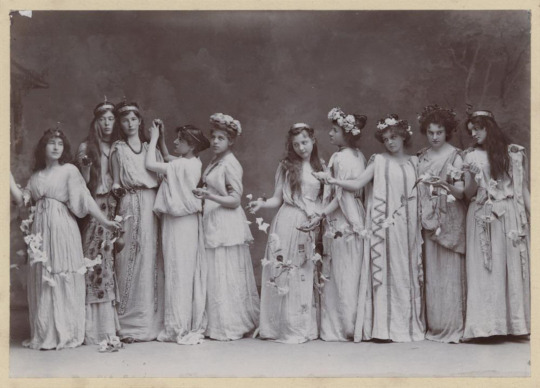
Scene for Marie Haushofer’s play “Twelve Culture Pictures from the Life of Women” (1899) zweites Bild: Die fünf weisen und die fünf törichten Jungfrauen [The five wise and the five foolish virgins]
read & view more on wordPress

siebtes Bild: Frauenlob wird zu Grabe getragen [Frauenlob (Heinrich von Meissen) burial] [danke @need-reality-asylum]
Marie Haushofers Festspiel zum Ersten allgemeinen Bayrischen Frauentag in München, 18. – 21. Oktober 1899
#atelier elvira#women day#women rights#women rights movement#marie haushofer#marie haushofer festspiel#festspiel#role of women#role portrait#group portrait#modern women#women artists#Sophia Goudstikker#1890s#rollenporträt#frauentag
60 notes
·
View notes
Text
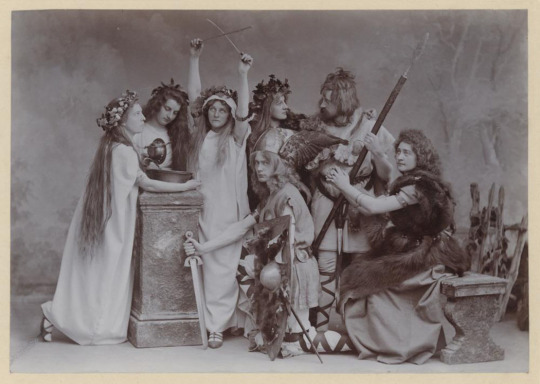
Szenenfoto aus dem Festspiel, fünftes Bild: Germanen und Velleda [Teutons and Velleda]
From : Twelve group representations [„Zwölf Culturbilder aus dem Leben der Frau“]. The piece was written by the painter a poet Marie Haushofer (1871-1940) and Sophia Goudstikker directed it. A few days later, Goudstikker photographed the twelve group portraits in Atelier Elvira. She glued the photographs into a leather album entitled "Marie Haushofer's festival for the first general Bavarian women's day in Munich. October 18-21, 1899 "
read & view more on wordPress
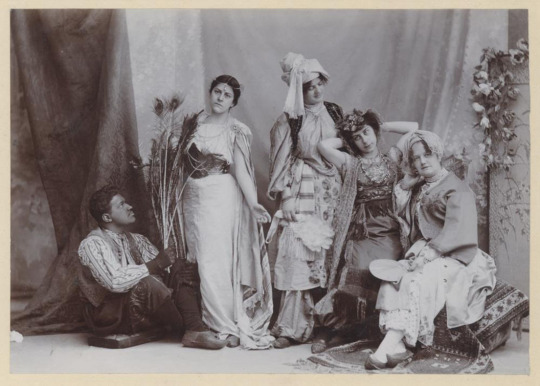
Szenenfoto aus dem Festspiel, viertes Bild: Orientalinnen [Oriental women]
#atelier elvira#marie haushofer#1890s#women rights movement#hof-atelier elvira#women rights#women artists#role portrait#marie haushofer festspiel#scene photo#szenenfoto#women day#Sophia Goudstikker#turn of the century
49 notes
·
View notes
Text

Atelier Elvira :: Tänzerin, Gelatineentwicklungspapier, undatiert. | quelle: Münchner Stadtmuseum, Sammlung Fotografie
#atelier elvira#dancer#Tänzerin#danseuse#danzatrice#dance costume#dance pose#tanzpose#Anita Augspurg#tanzköstum#oriental costume#women artists#Sophia Goudstikker
58 notes
·
View notes
Text
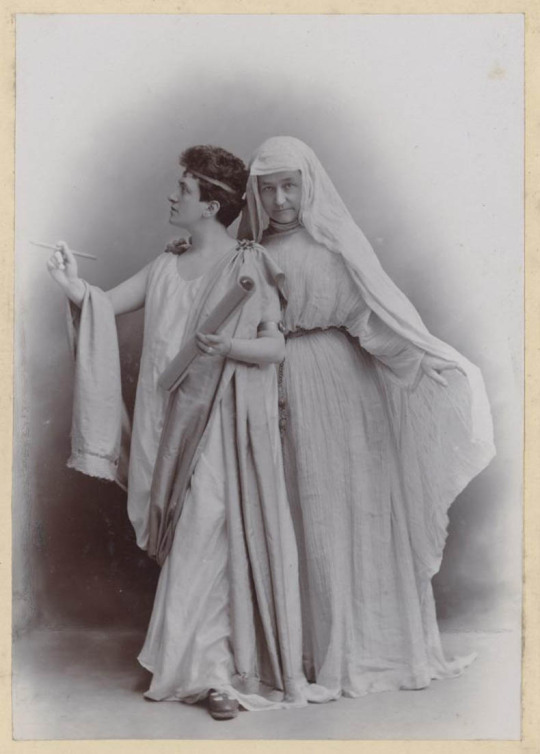
Der Muse der Geschichtsschreibung Klio (gespielt von Sophia Goudstikker) und der Mutter Erde (gespielt von Therese Schmid) [The muse of history Klio (played by Sophia Goudstikker) and Mother Earth (played by Therese Schmid)]
view & read more on wordPress
Szenenfoto aus dem Festspiel, erstes Bild. Scene for Marie Haushofer's play "Twelve Culture Pictures from the Life of Women" (October 18-21, 1899), created in Atelier Elvira by Sophia Groudstikker
#Atelier Elvira#Sophia Goudstikker#role portrait#szenenfoto#theatrical costume#womens day#frauentag#Anita Augspurg#Festspiel#Marie Haushofer#Marie Haushofers Festspiel#women rights#1890s#Hofatelier Elvira#Munchen#Munich#women rights movement#Therese Schmid#women artists
40 notes
·
View notes
Text
"Sophia Goudstikker"– Ingvild Richardsen erzählt das Leben einer unglaublichen Frau - "Frauenpower 1900":
“Sophia Goudstikker”– Ingvild Richardsen erzählt das Leben einer unglaublichen Frau – “Frauenpower 1900”:
https://literaturradiohoerbahn.com/wp-content/uploads/2024/03/S-Goudstikker-Frauenpower-1900-upload.mp3
Gespräch zwischen Ingvild Richardsen und Uwe Kullnick (Hördauer 82 Minuten)
Sophia Goudstikker kommt 1865 in Rotterdam zur Welt und stammt aus der niederländisch-deutsch jüdischen…
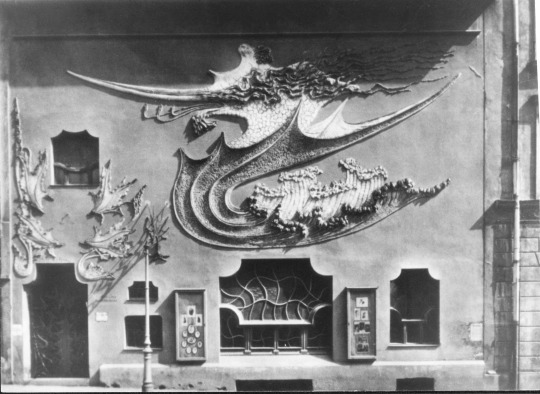
View On WordPress
#Anita Augspurg#August Endell#Berthe Ruchet#Carry Brachvogel#Emma Merk#Emmy von Egidy#Evas Töchter#Frauenbewegungen#Gabriele Reuter#Hermann Obrist#Ingvild Richardsen#jugend#Jugendstil#S. Fischer Verlag#Simplizissimus#Sophia Goudstikker#Uwe Kullnick
0 notes
Photo

Group of German women's rights activists at an international women's conference in Germany. From left to right: Anita Augspurg, Marie Stritt, Lily Braun, Minna Cauer, and Sophia Goudstikker. Photograph, c1901.
6 notes
·
View notes
Text
Autoren: "Die Münchner Frauenbewegung und der Jugendstil"– Kap. 9 aus "Leidenschaftliche Herzen, feurige Seelen" von Ingvild Richardsen
Autoren: “Die Münchner Frauenbewegung und der Jugendstil”– Kap. 9 aus “Leidenschaftliche Herzen, feurige Seelen” von Ingvild Richardsen
https://literaturradiohoerbahn.com/wp-content/uploads/2020/06/Autor-Leidenschaftliche-Herzen-Ingvild-Richardsen-Auszug-9-upload-.mp3 Autoren: “1896: Die Münchner Frauenbewegung und der Jugendstil”– Kap. 9 aus “Leidenschaftliche Herzen, feurige Seelen” von Ingvild Richardsen Wer weiß schon, wie der Jugenstil entstand und wie er zu seinem Namen kam?
Ingvild Richardsen erzählt in ihrem aktuellen…
View On WordPress
#Anita Augspurg#August Endell#Berthe Ruchet#Carry Brachvogel#Emma Merk#Emmy von Egidy#Evas Töchter#Frauenbewegungen#Gabriele Reuter#Hermann Obrist#Ingvild Richardsen#jugend#Jugendstil#S. Fischer Verlag#Simplizissimus#Sophia Goudstikker#Uwe Kullnick
0 notes
Text
Lesung: Ingvild Richardsen liest aus "Leidenschaftliche Herzen, feurige Seelen"
Lesung: Ingvild Richardsen liest aus “Leidenschaftliche Herzen, feurige Seelen”
https://literaturradiohoerbahn.com/wp-content/uploads/2019/09/Ingvild-Monacensia-Leidenschaftliche-upload.mp3 Lesung: Ingvild Richardsen liest aus “Leidenschaftliche Herzen, feurige Seelen”
Aus den Beständen: „Leidenschaftliche Herzen, feurige Seelen“. Wie Frauen die Welt veränderten
Buchpremiere mit Ingvild Richardsen
Moderation: Roland Spahr, S. Fischer Verlag
Lesung: Thomas Birnstiel
Ingvil…
View On WordPress
#Anita Augspurg#Carry Brachvogel#Emma Merk#Evas Töchter#Frauenbewegungen#Gabriele Reuter#Ingvild Richardsen#Monacensia#Roland Spahr#S. Fischer Verlag#Sophia Goudstikker#Thomas Birnstiel
0 notes